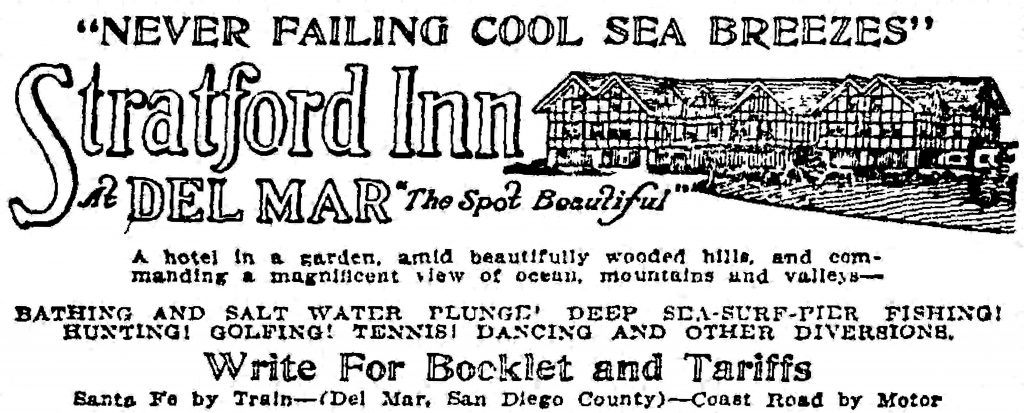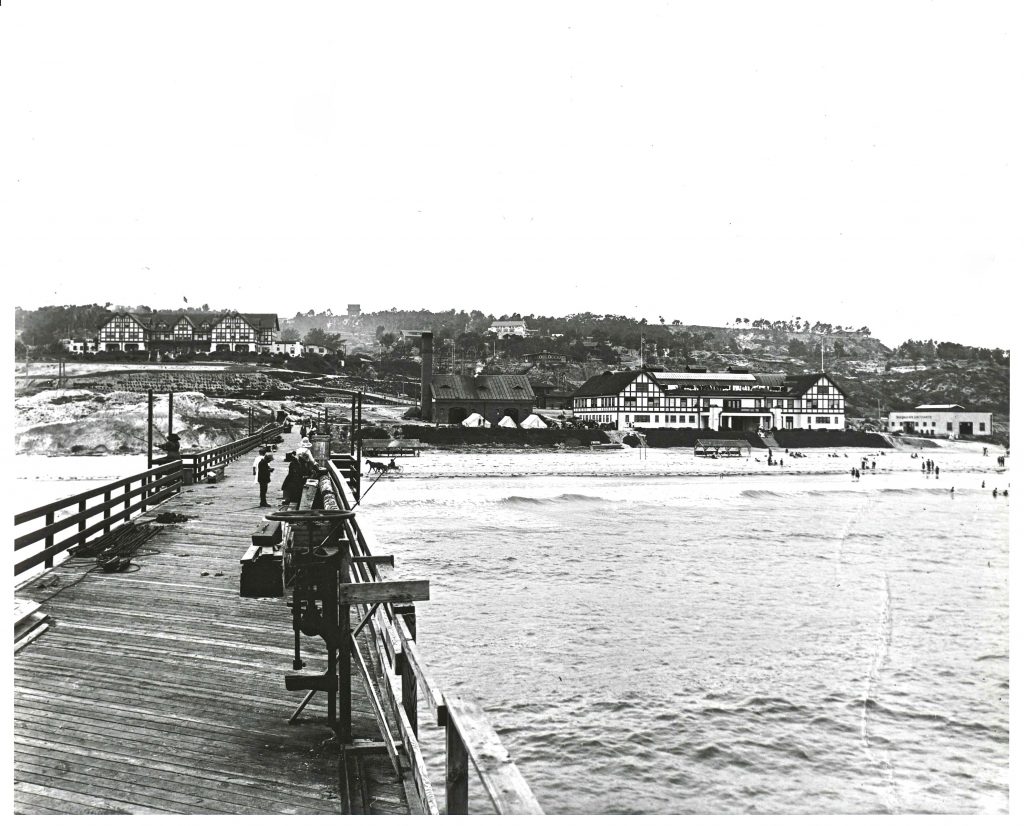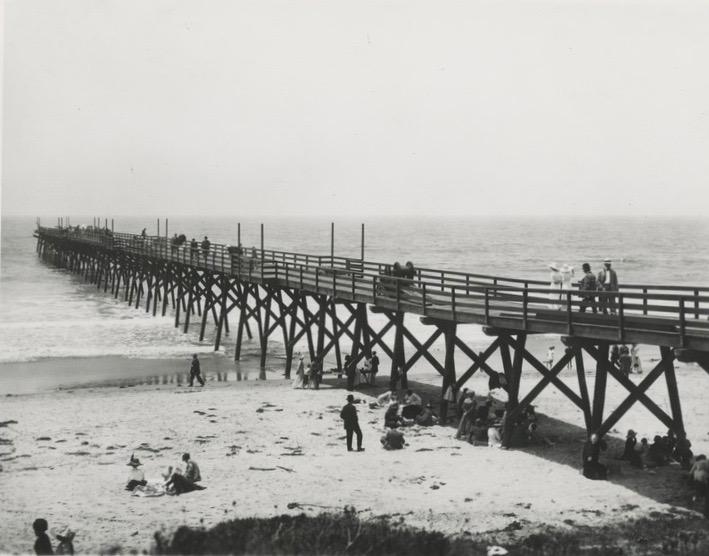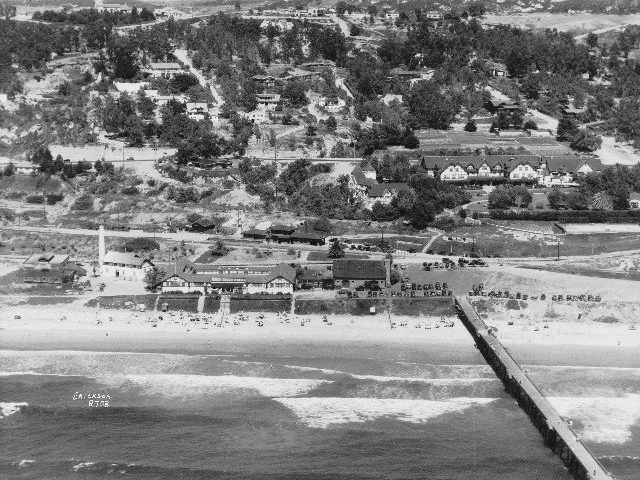Although today’s Oceanside Pier is the first pier to be encountered north of San Diego, that hasn’t always been the case. The north county area saw several wharves and “pleasure piers” come and go over the years, piers at Del Mar, Carlsbad and Cardiff by the Sea. The most famous and longest lasting was the pier at Del Mar, due in part to various reincarnations and private versus public nature.
In August 1882 the first California Southern Railroad train traveled over the new tracks from San Diego to San Bernardino. At the same time Theodore M. Loop, the contractor and engineer for the project, built a tent city on the beach and his wife Ella named it Del Mar, the words taken from a popular poem of the time.
Colonel Jacob Taylor who had moved into the area, met Loop who suggested building a new town. Taylor bought 338 acres of land and founded Del Mar. His vision was that of a seaside resort basically for the rich and famous and the focal point would be a hotel-resort. He quickly started construction of the Casa del Mar resort. The resort included a swimming pool that went out into the ocean (a Natatorium) that was “safe from the dreaded stingaree,” and a dance pavilion close to shore. Last but not least was a pleasure pier. It is not reported if fishing was allowed from the pier, although that is a natural expectation. Unfortunately the resort burned to the ground in 1890 and the town of Del Mar itself was relocated a half mile to the north in 1915.

In 1909 William G. Kerckhoff and the South Coast Land Company opened the large Stratford Inn in Del Mar. Later called the Del Mar Hotel, it was a world-class hotel that eventually would became a magnet for Hollywood stars. Among the hotel’s amenities were a salt-water swimming pool (the Plunge), a bathhouse, golf course, and a “pleasure pier” that was constructed in 1909 (or 1912). The plunge and pier were the main attractions.

The Del Mar Pier (known to locals as the 15th Street Pier since it was between 15th and 17th streets) was 1,000 feet long and originally designed to be used by hotel guests. At the end of the pier was a pump house that was used to pump seawater into the “Plunge.” The pier was a popular haunt and provided, according to early records, “superb fishing.” A newspaper ad dated January 1, 1917 reported: “the thousand-foot pier, where the gamiest fish, weighing from one to thirty pounds, are caught is a great attraction to the man with rod and reel.”

Of course like any seaside pier, damage from storms was always a possibility.
Breakers Wreck Pier
Del Mar, April 8.—For the second time this season, the end of the Del Mar pier was torn off by breakers last night, 110 feet being carried away. The first storm struck in February, while it was being rebuilt, smashing away nearly 200 feet. Rebuilding started at once, and the new pier would have been completed today, but for last night’s storm. The damage amounts to about $5000. —Los Angeles Times, April 9, 1926
Long Pier Completed At Del Mar
Del Mar, Aug. 14.—A 1200-foot fishing pier constructed by the South Coast Land Company at Del Mar for the benefits of residents of the community and guests at the Stratford Inn, there, has just been completed, according to officials of William Ledbetter and Company, the Los Angeles firm which built the pier under contract. The piling supporting the pier is imbedded in solid sandstone. A separate hole was drilled and casing inserted before each pile, of which there are several hundred, could be driven. Early construction on the pier was halted in April by the heavy storms along the coast, which washed out approximately 200 feet of the partially completed pier, necessitating the drilling of new holes opposite the piling which was broken off by the heavy seas, and new piling driven to support the structure. “The completion of this pier at a cost of approximately $50,000,” said E. M. Claussen, sales manager of the South Coast Land Company, “adds materially to the recreational advantages at Del Mar. —Los Angeles Times, August 15, 1926
Unfortunately, just five months later, on January 3, 1927, it was reported that “heavy seas believed a result of an earthquake have knocked the end off the new Del Mar pier.” Once again the pier would be repaired.
In conjunction with the new pier, the South Coast Land Company had decided to bring in a fishing barge that would see the pier as its home base. The news wasn’t too surprising since most of the large SoCal piers had begun barge fishing by the late ‘20s and the barges would prove very popular with anglers through the ‘30s and only ended with the advent of WWII and various restrictions during the war. The barge at Del Mar was to be the George E. Billings, an old ship that was to be renamed the Del Mar.
Famous Old Clipper Retired — Will be Floating Fishermen’s Resort
Del Mar, Nov. 18.—Many a man who has won success or prominence has settled down in Del Mar when he retired from active business life, but the famous old clipper, George E. Billings, is the first ship to follow that example. The Billings, a five-masted schooner, which once held the record for the fastest trip between Honolulu and San Francisco, and generally known as the fastest sailing vessel on the Pacific is going to be anchored about a mile off the end of the Hotel Del Mar fishing pier and turned into a floating fishermen’s resort, with a grill and all that sort of thing so that they won’t even have to stop fishing to go to their meals, as has been necessary heretofore. The name of the ship will be changed to the Del Mar. —Los Angeles Times, November 19, 1926
What wasn’t mentioned in the news announcement was a few less than stellar facts about the ship. In 1921 the ship was becalmed for 83 days on a voyage and saw the five seaman who had starved to death eaten by their starving shipmates. Or the fact that the ship, along with most ships of its type, was taken to the windjammer graveyard at Alameda in San Francisco Bay in 1924, eventually to be scraped. Instead it was sold to be a fishing barge; in a way it was being given a second chance of life. Unfortunately the barge business at Del Mar never generated enough profits and the ship was sold and moved to the Ocean Park Pier in Venice in 1929.
Other changes were seen at the pier as the pier entered the ‘30s. The pier now had a bait house at the entrance, a lifeguard tower, and was supposedly open to the public—except that a high fence at the entrance said “Caucasians only.” But the pier was popular. During the “Great Depression,” people needed a low cost venue for entertainment (and food) and it was provided by the pier. All that was needed was a board to wrap some line around (most didn’t have a rod and reel), a few hooks and sinkers, and bait that could be obtained for free from the surf (sand crabs) or the pilings (mussels, small crabs and worms). Perch, croaker, corbina, bass, halibut and more were available from the pier and all provided food that was not wasted.
Unclear is the amount of damage incurred by the pier during a large storm a few years later in 1932; some reports said only parts of the pier were left standing.
But Del Mar itself was changing. In October of 1936 the Del Mar Fair first opened and the fair with its mile-long oval Del Mar Racetrack was an instant success; to some degree it put Del Mar on the map. For the rest of the ‘30s and most of the ‘40s the hotel and nearby racetrack became the playground of Hollywood stars including Bing Crosby, Pat O’Brien, the Ritz Brothers, Oliver Hardy, Lucy and Desi Arnaz, and the town’s favorite, Jimmy Durante, who frequently fished from the pier and the nearby surf.
Of course Mother Nature can put a damper on the fun and a storm with rough seas and high waves brought new damage to the pier early in 1939.
Damage in South
The swollen seas tore at San Diego beach communities today, menacing the Mission bay Bridge, sweeping across streets and flooding homes in Mission and Ocean Beach and ripping away part of the Del Mar Pier. —Modesto Bee and News-Herald, January 6, 1939
The WWII years were also challenging. The nearby racetrack was used for the war effort. The grandstand became a bomber tail assembly production facility while much of the fair grounds were used to house and train Marines. Included in the training were swimming lessons in the Del Mar Hotel’s Plunge (saltwater swimming pool). Unfortunately, swimming in the plunge in swim suits did not prepare all for what was to come next. One training exercise required recruits to run from the racetrack to the beach (about .8 miles) in full gear. Once there, they had to run out to the end of the pier, jump into the ocean, and swim back to shore. Apparently some drowned and didn’t make it back.
By the ’50s the pier was in sad shape. Simple age, stress from the pounding waves, occasional damage and repair, and less than perfect upkeep had taken its toll and many began to call for the dismantling of the old pier. It appeared doomed but then, in 1955, news appeared that gave hope that a new pier would be built in Del Mar.
Del Mar Fishing Pier Plans Set
Del Mar UPI—Plans for a million-dollar Del Mar sports fishing pier were reported today by Carl McCullah of Newport Beach. McCullah, president and general manager of the Pier Del Mar Corp., said the 2,000-foot pier would be completed in May. The plans also include a barge to be anchored two miles off the pier for fishermen. The company proposes to operate boats between pier and barge. —Long Beach Press-Telegram, November 15, 1955
Unfortunately, reports in April 1956 announced that the plans to construct the pier had been abandoned due to high construction bids—while the old pier continued to deteriorate. June 6 the pier was declared unsafe by the San Diego County Sheriff’s office and public warning signs were posted.
Old Pier
Del Mar, June 10—The Chamber of Commerce board of directors has sought permission to remove the old wooden fishing pier. Clearance has already been obtained from William Burris of Newport Beach, one of the owners. Still to be secured are permits from the County Board of Supervisors, Army Engineers and the Coast Guard. Last year, at request of the Sheriff’s office and County Lifeguard Service, the pier was declared unsafe, and to discourage visitors from walking on the structure the outer section was removed. —Los Angeles Times, June 11, 1957
When it was finally decided that the pier was a nuisance, and that it needed to be torn down, there was a slight problem. The county didn’t want to pony up the $8-10,000 needed for demolition. Instead, it recruited the Navy’s Underwater Demolition Team from Coronado to do the work as a training exercise. The pier and the lifeguard tower were finally demolished in 1959, the same year the Del Mar Hotel was closed. Today, the posh and expensive Inn L’Auberge at Del Mar sits on the site.
Del Mar Pier Fish: I’ve only found a few fish reports from the pier. One fish report regarding the Del Mar Pier is a report from the Scripps Institution of Oceanography that said a yellow snake eel (Ophichthus zophochir) was taken by hook and line off the Del Mar Pier on August 6, 1960. The catch is interesting since yellow snake eels once were considered rare in California and are still somewhat uncommon. More interesting, or perplexing, is the 1960 date, it’s a year after the pier was supposed to have been destroyed.
Good Fishing From Pier At Del Mar
Ed Gerson, consistent and successful angler, is advertising his corbina-loving friends to journey to Del Mar Sunday with plenty of Pismos wrapped up in gunny sacks. Allie Meyer, Seymour Swartz and Ed Gerson landed sixty-two good-sized corbina from the Del Mar Pier on July 4 between the hours of 8 and 11:30 a.m. —Los Angeles Times, July 7, 1917
Fishing is exceptionally good at Del Mar at the present time. Corbina, spot fin, yellow fin, halibut, white fish and barracuda are being caught in great quantities off the one-quarter-mile Del Mar fishing pier and at the mouth of the San Dieguito River about a mile north of Del Mar. Deep-sea fisherman also report tuna, swordfish, bonito, yellowtail, barracuda and skipjacks are running fine right now. “Del Mar has become more and more popular each year as a sports resort,” reports Arthur Stock, manager of the Del Mar Hotel.” —Los Angeles Times, August 14, 1927

In regards to the Del Mar pier, I well remember iit was blown up by the navy in 1960, not 1959.
“I always value the practical advice you offer. Thank you for sharing your expertise!”